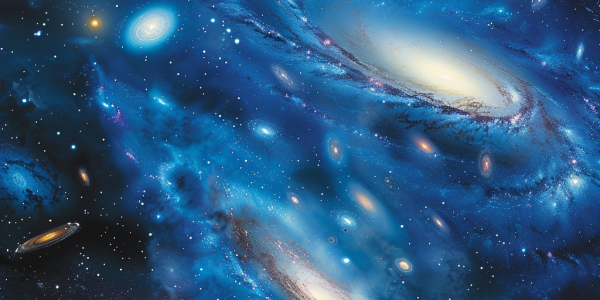New Theory Suggests Asteroids May Cause Fast Radio Bursts
A new study led by Dang Pham from the University of Toronto suggests that fast radio bursts (FRBs) may be caused by asteroids colliding with neutron stars, rather than the previously believed neutron star collisions. This research, published in the Astrophysical Journal, explores the frequency of interstellar asteroid impacts and their correlation with FRB occurrences, providing fresh insights into these powerful cosmic phenomena.
New Research Uncovers Secrets of Elliptical Galaxy Formation
Recent research from the University of Southampton reveals that massive cosmic collisions around 12 billion years ago were crucial in the formation of elliptical galaxies. This groundbreaking study, published in Nature, highlights how the collision of disc galaxies led to intense star formation, reshaping our understanding of galaxy evolution in the early universe.
Discovery of Unusually Aligned Dwarf Galaxies Challenges Dark Matter Theories
A groundbreaking discovery reveals a group of dwarf galaxies aligned in a near-straight line, challenging existing theories of dark matter and galaxy formation. Researchers, led by Sanjaya Paudel from Yonsei University, found these galaxies 117 million light-years from Earth, exhibiting coherent rotational dynamics that contradict the cold dark matter model. This study opens new avenues in astrophysics, suggesting the need for reevaluation of dark matter’s role in the universe.
Breakthrough Discovery of Complex Carbon Molecules in Interstellar Cloud Sheds Light on Origins of Life
A groundbreaking discovery by MIT scientists reveals complex carbon molecules, specifically pyrene, in a distant interstellar cloud. This finding enhances our understanding of the origins of life and suggests that these organic compounds could have contributed to prebiotic chemistry on Earth. The detection of pyrene challenges previous notions about the survival of complex molecules in harsh cosmic environments, opening new avenues for research into the building blocks of life in the universe.
NASA Advances KU’s PRIMA Mission for $1 Billion Astrophysics Project
NASA has announced the advancement of the PRobe far-Infrared Mission for Astrophysics (PRIMA), co-led by KU’s Elisabeth Mills, to the next stage of consideration for a groundbreaking $1 billion mission aimed at exploring the cosmos in the 2030s. This mission focuses on detecting far-infrared radiation to unlock secrets about the formation of planets, galaxies, and the origins of Earth’s water, marking a pivotal moment in astrophysics research.
JWST Findings Challenge Timeline of Universe’s Reionization Epoch
Recent findings from the James Webb Space Telescope challenge established theories on the epoch of reionization, suggesting it may have ended 350 million years earlier than previously thought. This pivotal period, marked by the formation of the first stars and galaxies, plays a crucial role in our understanding of cosmic evolution. Discover how these groundbreaking observations are reshaping our knowledge of the universe’s infancy.
Newly Discovered Satellite Galaxies Surrounding HSC-SSP Area Unveiled by Researchers at Tohoku University
A recent study by researchers at Tohoku University has uncovered numerous satellite galaxies in the HSC-SSP area, previously unknown and identified through advanced technology. This discovery provides valuable insights into the cosmos, shedding new light on the Milky Way, dark matter, and the dynamics of the universe.
Scientists Call for Better Protection of the Moon from Development
Scientists are calling for the protection of the moon from development to safeguard its valuable sites for scientific study. The lunar surface’s most precious sites for scientific study are under threat from mining, satellites, and bases, as a groundswell of pending projects are on the horizon. With a limited number of desirable lunar sites, researchers argue for the protection of these extraordinary scientific important sites (SESIs) in order to preserve their scientific importance.
Carl Sagan’s Cryptic Message for Future Mars Astronauts
Astronomer Carl Sagan left a cryptic message for future humans on Mars before his death in 1996. The message, pondering the reasons for human presence on Mars, was sent to the Red Planet aboard NASA’s Phoenix lander and arrived in 2008. Sagan’s message serves as a reminder of humanity’s enduring fascination with Mars and ongoing efforts to explore and understand the mysteries of the Red Planet.
Astronomers Discover Brightest and Most Voracious Black Hole Ever Detected
The discovery of the brightest and most voracious black hole ever detected, known as J0529-4351, has left astronomers in awe. This remarkable finding was confirmed through observations by the Very Large Telescope in Chile. Scientists revealed that the black hole devours the mass equivalent to one Sun every day, highlighting its insatiable appetite. J0529-4351, although recorded in data many years ago, has only recently been recognized for its true glory. Quasars like J0529-4351 are the energetic cores of galaxies powered by immense black holes, known as Active Galactic Nuclei (AGN). The quasar’s emission, which took 12 billion years to reach the detectors at the VLT, is over 500 trillion times more luminous than the Sun, making it an astonishing discovery in the field of astronomy.










